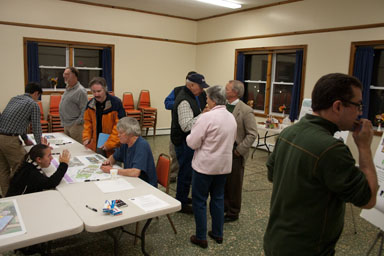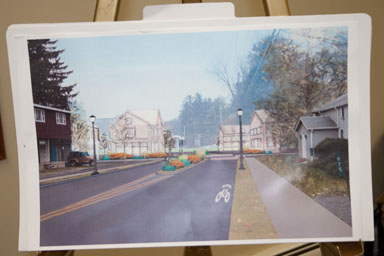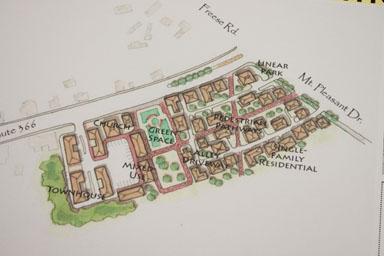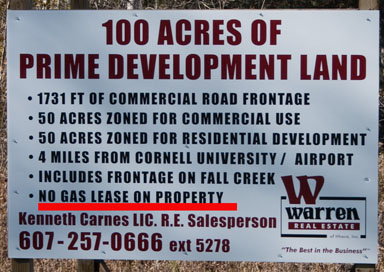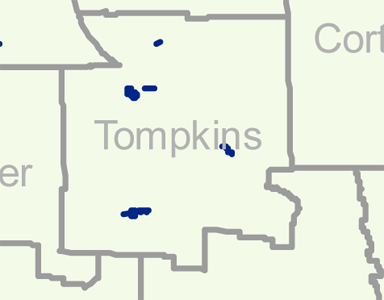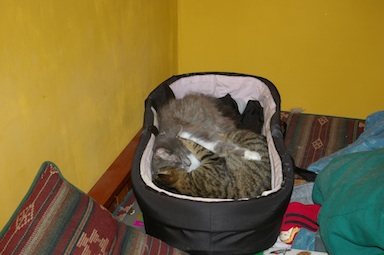November 1, 2011
Stolen Dryden car found in Ithaca
Two teens, one from Dryden, one from Groton, were found driving a stolen Dryden car in Ithaca last week.
There's another piece about Thursday's recreation meeting at Town Hall, this one with a lot more detail and some pictures of what's being proposed on those 55 acres. The meeting will be at 7:00pm at Dryden Town Hall, 93 East Main Street (Route 392) in Dryden.
There's also another public hearing, this one in Ithaca, on TCAT service changes and rural fare increases. It looked like only two people came to the one held at Town Hall earlier this month.
Does keeping gas drilling out make sense?
Yes, completely. If you still want more conversation, though...
The Ithaca Journal has a pro-ban anti-drilling piece from County Legislator Martha Robertson and a pro-drilling anti-ban piece from Dryden Safe Energy Coalition spokesman Henry Kramer.
I'm very happy to see that the Journal recognized that Henry Kramer's stance is not the middle of the road and that his gas industry propaganda needs to be presented with an opposing view. It's still a mix of his prophet of doom act on lawsuits and his prophet of sunshine and unicorns on the benefits, but it's hard to imagine Kramer acknowledging other possibilities at this point.
Robertson's point is simple: fracking is a threat to our $1,000,000,000+ in assessed property value, and the costs of protecting that are relatively small. Residents seem to get that.
Update: More on the legal side here.
There's also a piece on drilling and wildlife.
November 2, 2011
Varna hamlet plan meeting tonight
There will be a meeting at the Varna Community Center (943 Dryden Road/Route 366) tonight from 7:00pm to 8:30pm to discuss the proposed Varna Master Plan.
I haven't seen it yet, so I'm totally curious about what they've come up with.
Seward still pushing for home rule, supporting bans
I was a little worried that State Senator Jim Seward had gone quiet on his earlier support for clarifying that municipalities can zone out gas drilling. Fortunately, WBNG-TV reports that he's still interested in a piece on the Middlefield lawsuit:
State Senator Seward is pushing legislation to also interpret the law.
"My legislation would clearly give local governments the authority to through their local land use planning process and local zoning to determine whether or not this is an allowed activity or not," says Senator Seward.
The State Senate has decided not to move forward with any gas drilling bills until the DEC concludes its study, which means until then, Huntington's lawsuit in Middlefield takes center stage.
His fellow Republicans don't seem willing to allow his legislation to move forward, which is unfortunate given that Dryden is being sued in the meantime.
Perhaps the most interesting other bit of that article is the closing:
Company President Raymond Savoie says it is letting leases drop in Otsego County.
"Some of these areas are just getting misinformed. The best thing to do is just move forward to other counties," says Savoie.
I'm guessing that's just PR (plus some attitude about "misinformed"), because in the Middlefield case the landowner is taking point instead of the gas company, but it sure would be nice to hear Anschutz acknowledge that it's not welcome here and start pulling up stakes.
My guess is that Seward's speaking out and this (not to mention his right-wing colleague Greg Ball) means that Republicans are still possibly going to allow some kind of local control compromise on drilling, eventually. In the meantime, I'm sure their colleague Tom Libous will enjoy holding us all hostage to the gas companies and their lawyers.
November 3, 2011
Lots of election-related news
I'm about 20 stories behind on pieces I wanted to write before the election, with little sign I'll get them done. Still, there's lots popping up, so...
There was a piece on Dryden's fracking ban on NPR's Morning Edition this morning. Town Supervisor Mary Ann Sumner is interviewed, while her challenger, Bruno Schickel isn't there. Maybe he was embarassed by his last outing on public radio?. Instead, we get more Henry Kramer cheering on industry and spreading fictional math.
In the Dryden Courier, Glynis Hart has conversations with both Mary Ann Sumner and Bruno Schickel.
The Ithaca Journal reports on Tuesday's candidates forum in Varna, and has a viewpoint piece from Bruno Schickel. I'm guessing there will be a matching piece from Mary Ann Sumner at some point?
The Journal also asked local candidates "What is the most important issue facing the Town of Dryden in the next four years and how will you manage it?" Deborah Shigley, Republican, "did not answer this week's question", but you can find answers from:
I should probably mention that Joe Solomon is registered without a party, but is running on the Democratic line.
There's also mention of the wireless broadband project's construction getting underway, supported by a grant from New York State.
Finally, there's an article on water issues and gas drilling on the front page that's well worth reading. I hope to come back to it for a closer exploration.
Varna Master Plan presentation
I went to last night's presentation about the Varna Master Plan project to see what they'd come up with. I liked that they didn't actually have a presentation per se, but instead had maps, drawings, posters, and people to talk with. That worked nicely.
What they actually showed was a pretty dramatic proposed increase in density. Obviously, it wouldn't all be built at once, and I suspect large parts of it will never be built, but it did take a deep breath to look at it.
The reason that this master plan "didn't make me want to scream", as I mentioned and someone immediately wrote down as a comment, is that it was actually thought through as neighborhoods with variation, rather than as maximized apartment/townhouse complex density. There are a lot of small - but separate - buildings mixed in with what's still a fair number of townhouses. It doesn't give the sense of walls across the landscape, however, and walkways get as much emphasis as driveways.
One of my favorite pieces of the proposals was in a place I hadn't seriously considered for additional development, around the yellow house on the southwest corner of the Freese / 366 / Mount Pleasant intersection.
That's a lot of houses packed into a small area, I think effectively adding two or three layers of houses behind the ones fronting Route 366. Look closely, though, and it's very deliberately walkable, with alleys rather than roads or traditional driveways. What's more, much of that pedestrian area is meant to encourage people to walk through from the corner to the railroad-bed trail - and that kind of walking through generally reduces crime.
By looking at Varna as a set of areas - neighborhoods - and how they might be connected, they managed to place a variety of different kinds of housing into a complicated landscape. Forest Home Circle could actually be a good place for a few townhouses. Mixed use at the corner of Freese, Mount Pleasant, and 366 makes good sense.
There's much much more. I've posted a gallery of pictures, which breaks down more or less like:
- Main map
- People
- Area-by-area maps
- Explanatory posters
- Transportation
- Rough images of built-out areas
That last piece - the rough images - is probably what scared me the most. If someone showed up with plans for lots of blank cubes, I'd want them to go away immediately. I also found some of the townhouse images incredibly bleak. As a way of showing what these might look like in the landscape, they're very useful, but they're also a reminder that lousy architecture can doom a project completely.
The other piece of this that I worry about is how it fits with existing structures. It didn't feel like they treated the whole area as one giant teardown, but I worry about the structures - many of them actually attractive, or possibly attractive if their landlords didn't think of them as rent machines on their way to teardown - along 366. Again, architecture matters a lot here.
I also still worry about in-between densities. This at least feels like it might avoid the suburban slum effect, of density that is too high to be comfortable but too low to generate things to do and resulting safety - but I'd want to be very careful about how the pieces came together. I think that absolutely has to remain the Town's responsibility, not developers'.
In general, though, this was a lot less painful than I expected.
November 4, 2011
WBNG on Anschutz suit
WBNG-TV Binghamton has a report on today's upcoming hearing in the Anschutz lawsuit.
My reading of the Anschutz lawsuit
I reviewed the thick stack of filings last night. I am not a lawyer, but basically I hear this from the two sides:
- Anschutz
The DEC has historically interpreted the Environmental Conservation Law to give it lots and lots of power. It's convenient for us to have the DEC have that power, so how dare you consider that they might not have it?
- Town of Dryden
Past Court of Appeals precedent in mining cases based on different but similar law has left substantial zoning power with Towns for just this kind of thing. There's nothing in the law or its supporting documents to support Anschutz's claim that the DEC is in charge of everything.
To me, it looks like the Town should win fairly easily - and be able to fend off "takings" lawsuits because any "taking" involved would have happened in 1969, when the zoning was first passed.
I am, of course, not an attorney, and I was biased toward local control even before this issue came up. I understand that New York State law is its own set of especially twisted passages that make many mazes look straightforward - so we'll see!
It's likely a long path to the Court of Appeals, with court decisions in any direction at least possible along the way.
A morning in court
I took today off so I could watch my town get sued.
I suspect the best summary of this morning's proceedings came at its end, from Judge Phillip Rumsey:
It's wonderful to have such excellent work from everyone. It makes my job ... harder.
Most of the arguments were familiar from the written submissions, though apparently there's been an additional round of filings I need to get. Update: It looks like they're available from the West firm, per One of Nine.
Arguing for Anschutz, Attorney Thomas West pushed for an interpretation of the Environmental Conservation Law that gave maximum power to the state and the Department of Environmental Conservation, while on the Dryden side Town Attorney Mahlon Perkins challenged that interpretation of the law's intent and made it very clear that whatever else the DEC may be, it is not a land use management organization. Towns are.
I thought Judge Rumsey asked slightly sharper questions of West than of Perkins, but that may simply be because of the nature of the arguments. West also seemed to reach a lot harder into realms like foreign policy and energy independence. Talking repeatedly about "clean-burning indigenous resources" sounded very strange after a little while.
There were a few surprises:
I didn't see anyone from the Dryden Safe Energy Coalition there. Has this case become too politically radioactive for them to show up?
There was a second (and third) attorney sitting with Mahlon Perkins at the respondents' table. If I got this right, he was Alan Knopf, working as an intervenor on behalf of the Dryden Resource Awareness Coalition. His status in the case doesn't yet seem settled, and I guess it's the judge who determines it.
At one point, Tom West was going on at length about a missing DEC memorandum on the intent of the Environmental Conservation Law that no one could find. Judge Rumsey interrupted him eventually with "Mr. Perkins has it."
There were probably twenty Dryden residents there, and about as many people from elsewhere who have been working on this issue. Assemblywoman Barbara Lifton was there, and I saw people from Danby, Caroline, and Ithaca as well.
At least four Dryden Town Board members were there - I saw Supervisor Sumner, Steve Stelick, Joe Solomon, and Jason Leifer.
I think my favorite part of the proceeding came when Attorney Perkins asked whether natural gas companies are claiming more exemption from land use regulation than churches and schools. I need to take another look at the SGEIS, but Attorney West's sputtering reply about setbacks applies mostly to sources of water and not to other land uses.
Overall, this felt good for the Town, following the lines I described this morning.
While West was an excellent presenter, I thought he overreached badly a few times. Attorney Perkins did a great job outlining the questions in the case and why the court - not the DEC - has to be the one to decide this.
More soon.
Redistricting for the 2013 election
Yes, I've been kind of focused on this coming Tuesday, but not everyone is.
The Tompkins County Independent Redistricting Commission had built sixteen maps of possible new districts for 2013, but they've narrowed it down to four.
One has 15 districts and is much like the current map, especially in Dryden. There are also a 14-district scenario and two 13-district scenarios. The 14-district map changes the Dryden districts slightly, but the 13-district versions change the districts pretty drastically, especially on the west side of town.
Running a deficit, or not filing at all
When I last reported on campaign finance, Bruno Schickel's campaign was running a $1364 deficit and the Dryden Republicans hadn't yet filed their 32-day report at all. The Dryden Republicans did catch up on the 32-day report (they had $7092 on hand), but...
The Schickel campaign's 11-day report shows an $1166 deficit, while the Dryden Republicans, four days before the election, are a week behind on filing their 11-day-before-the-election report.
Meanwhile, the Dryden Democrats filing showed $2843.
November 5, 2011
Piles of election and fracking news
It's definitely been a busy week for Dryden. Here are pointers to some of the latest election pieces:
Incumbent Town Supervisor Mary Ann Sumner's Ithaca Journal piece on the biggest issue facing Dryden.
Video of the last candidates' forum is available on the Ithaca Journal website.
Town Board member Jason Leifer responds to Dryden Village Trustee Paul Rachetta's earlier charges about "deficit spending".
The Journal has a report on yesterday's oral arguments in Anschutz v. Dryden.
In slightly stranger fracking news, the Dryden Safe Energy Coalition is finally planning a new "education meeting" on "Water and Energy Development" the day after the election in, er, Binghamton.
It's one thing to hold a secret invite-only meeting where it's more convenient for the gas companies, but why would a Dryden group hold their public educational events an hour's drive away? With those "wishing to attend should give advance notice by e-mail "? Have they really made themselves that radioactive in Dryden?
Worst of all, though I'm assuming the Journal just printed their press release more or less as it came in, the Journal still somehow lets them get away with their nonsense "coalition said it is dedicated to the "middle way" in terms of energy development". The only thing worse than partisans are partisans who pretend they're not partisan.
November 6, 2011
Spring's Bench
When I lost my beautiful Spring dog in February, I knew right away that I wanted to do something permanent (as such things go) in her memory.

Spring keeping an eye on the neighborhood.
In May I bought a bench at Finger Lakes Stone, but it took a while to get it set up. We finally got the heavy seat on yesterday. I placed it where I think Spring always wanted to be, near the road, ready to bark, rather than where we let her be, closer to the house.
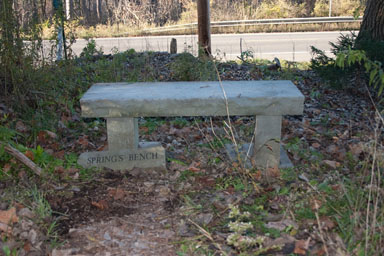
Spring's Bench, overlooking 366.
That corner used to be a wasted space, overrun with poison ivy, honeysuckle, and sumac that kept falling over. I have a long way to go before it's a nice garden, but it'll be easier to do knowing that it's for Spring.
November 7, 2011
How to spread budget doubts without precisely lying
Don't let the Republicans frighten you.
When I first followed a Dryden budget closely, I thought I was really going to be able to nail the then-Republican Town Board. True, they weren't raising taxes, but they were appropriating huge amounts of money out of the fund balance. Here was an obvious tool for demolishing the Republican candidates in 2005 or 2007...
Looking at reality, though, this story turned out to be pretty completely bogus. Yes, the Board was budgeting using a huge chunk of fund balance to keep taxes stable while covering the needs of government, but that money was coming back every year - even coming back with extra.
The large fund balances mostly reflected government that hadn't figured out how to separate out its checking account from its savings account. It also reflected over-budgeting followed by under-spending - Dryden government has remained pretty frugal, though budgets include lots of buffering to avoid having to make midyear course corrections if the price of, say, diesel or asphalt suddenly skyrockets.
Climbing pensions, healthcare, New York State's strange wobbling, and the reality of an economy in trouble have taken a toll on that fund balance - but it's a small one. Why? Because even in these more difficult years, the Town has still spent a lot less than was allocated. It's been difficult to follow the Comptroller's mandate to reduce our fund balance.
The Republicans avoid a flat-out simple lie by saying things like "the last 3 budgets have called for spending approximately $4.5 million from savings." They neglect to tell you that the last 10 budgets have called for spending around $15 million from savings - and didn't spend it.
How do the more recent numbers look?
In 2008, the Town Budget called for spending $1,321,000 from fund balance. Even in that crazy economic disaster year, they only spent $214,000 of that.
In 2009, the budget called for spending $1,884,329 from savings. Not only did they not spend it, they added $308,430 to the fund balance.
In 2010, the budget called for spending $2,381,718 from fund balance. They still only spent $959,246 of that - much of which (as I'll describe below) will come back, some with interest.
In 2011, the budget call for spending $2,674,137. We don't yet know how much will come back, but as sales tax revenue is looking much healthier than the Town budgets, it's a pretty safe bet that there won't be a deficit this year.
Terrified yet? No? Well, that's good. Once you get past the bumper sticker slogan and what amounts to double-billing, there isn't much to fear.
So where did lots of unexpected money go in 2010?
As the Republicans put it, "$688,000 spent on a one-time purchase of development rights for 1 farm." What they don't tell you is that the money is supposed to be from the State of New York, but in their own budget issues they were delayed. The Town decided to follow through on its obligation to a Republican dairy farmer who's leased his land and supports hydrofracking, covering the $688K until the state comes through with it - hopefully next year.
$259K went to the pension system - an early payment that earned us a $2K discount and will take pressure off future budgets.
$114,000 went to the Tompkins County Health Consortium to get things running. That money will also come back, with 3.4% interest - a lot more than savings accounts are yielding at the moment. It's part of a key project to reduce healthcare costs over the long run, by putting Dryden employees into a larger group of insured people.
$25,000 isn't coming back, except through your enjoyment of libraries. It was a one-time grant to the Southworth Library to help them get the building set up.
I'm sorry this took so long to explain, but the Republicans are clearly counting on it being more difficult to explain public finance than to assault it with scary-sounding slogans.
Don't let the Republicans frighten you.
Subtle but effective anti-fracking sign
"All those enviros who think they know better than the rest of us, they should just listen to the market" - or something like that - isn't too unusual a comment in the culture war side of the pro-fracking folks in places like Ithaca Journal comments.
As I was driving through Dryden the other day, though, I noticed this highly respectable market-oriented sign along 13/366.
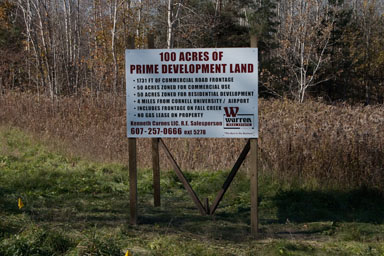
Warren Real Estate sign on Routes 13 and 366.
Wait - you mean that the future owners of that property might not want it to come with a pre-purchased opportunity to make huge amounts of money on gas exploration? That the current owners of the property might think it had more value as something other than well pads?
It even seems to be a missing link of a potential spacing unit - lease that parcel, and the gas companies could make the neighbors come along quietly through compulsory integration.
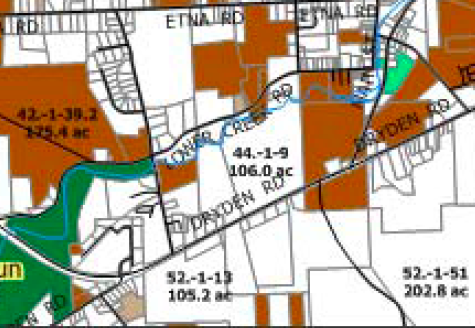
Warren Real Estate sign on Routes 13 and 366.
I guess we'll see what happens there, but for now I'm happy both that it's not leased and that the owners are announcing that to the world as a real estate value benefit.
Absentee ballot reminder
Today is Monday was the last day to return absentee ballots for tomorrow's elections in Dryden.
If you're mailing one, it must have today's postmark on it. That means it's best to take it into the post office counter and request today's postmark rather than drop it in a mail slot or box, where it might get tomorrow's postmark. (Yes, I've seen Dryden ballots disqualified because the postmark was election day instead of the day before.)
If you still need to get one, you can still apply at the Board of Elections, 128 East Buffalo Street. In that case, it's probably best to fill out the ballot there, put it in the envelope, and hand it right back to them.
(And if you signed up for an absentee ballot, but will be in town to vote, you can vote at the polls and the absentee ballot, if submitted, will be discarded. No one gets two votes!)
November 8, 2011
Where to vote
It's Election Day today.
Polls will be open today from 6:00am to 9:00pm. Remember that you can't campaign inside of the polling places, and that this includes things like T-shirts, signs, and buttons in addition to trying to actively convert everyone around you.
Everyone is now on the new machines, paper with an electronic scanner. Last year, I noticed that the marker they give you bleeds through the paper. They had folders to carry your ballot in, though, so I think it was sufficiently private. I still miss the old machines, though.
Depending on which district you live in - see the district map (597KB PDF) - you can vote at:
- Etna Fire Station - 26 Wood Road, Etna (map).
- Freeville Fire Station - 21 Union Street, Freeville (map).
- Dryden Fire Station - 26 North Street, Dryden (map).
- Varna Community Center - 943 Dryden Road, Varna (map).
- Etna Fire Station - 26 Wood Road, Etna (map).
- Dryden Fire Station - 26 North Street, Dryden (map).
- Dryden Fire Station - 26 North Street, Dryden (map).
- Bethel Grove Church Activity Center - 1749 Slaterville Road, Bethel Grove (map).
- Varna Community Center - 943 Dryden Road, Varna (map).
- Reach Out for Christ Church - 318 Johnson Road, Freeville (map).
- Dryden Fire Station - 26 North Street, Dryden (map).
If you'd like to see a sample ballot before going in, the Board of Elections has them (PDF).
November 9, 2011
Democrats sweep Town Board races
I never thought I'd see a Democratic win in Dryden this, well, crushing.
| Position | Candidate | Votes |
|---|---|---|
| Town Supervisor | Mary Ann Sumner | 2198 |
| Bruno Schickel | 1469 | |
| Town Councilperson | Joseph Solomon | 2215 |
| Linda Lavine | 2124 | |
| James Drew | 1474 | |
| Deborah Shigley | 1431 |
That's roughly a 3-2 margin across the board in unofficial results, and a lot more voters than typically turn out in off-off-year elections.
It looked like Democrats did well across the town, losing District 2 (Freeville) by about 21 votes and District 7 (east side of Dryden village) by about 76 - and swamping Republicans elsewhere. That didn't just mean huge margins in the southwest corner of town, though those were there - it also meant winning districts like 11 (Dryden Lake) that aren't traditionally Democratic.
I've have a lot more analysis when I have more detailed breakdowns (and more sleep), but overall this was a huge victory for the Dryden Democrats.
(Caroline surprised me even more, with anti-fracking candidates sweeping all three districts and even larger percentage margins.)
Update: Here's the Ithaca Journal's report.
November 10, 2011
Hydrofracking and the elections
Back at the public hearing in July, I asked Dryden Republican Committee Chair why they were pushing so hard against the ban. "Candidates", he said, before we were shushed. I was actually trying to give him some advice - I thought they'd taken on a political suicide mission even then.
This morning's Ithaca Journal reports on the impact of hydrofracking controversies on this year's local races. It wasn't just Dryden - Caroline swept two incumbents opposed to a ban out of office by even larger margins.
I think Town Supervisor Mary Ann Sumner gets the dynamics right:
In Dryden, Sumner said fracking was a divisive issue at the beginning of the campaign, but by the end there seemed to be a clear consensus.
I'm not sure "consensus" is the right word - there's still a clear division. Over the course of the fall, though, I kept hearing from and of people, often Republicans, who had looked at this issue and decided that ban, at least for now, was the right idea.
Anschutz suing the Town likely didn't help the Republicans either.
Henry Kramer, prophet of lawsuit doom is still singing his same old song:
"As far as the fracking issue, I am sure it played a part because the Democrats centered their campaign around the issue of fracking and in my view they did that because they didn't want attention on the budget deficit problem and zoning issue," he said. "It is easier to sell fear than to deal with numbers in the budget."
Kramer, who poured a lot of energy into the Dryden Safe Energy Coalition, is a strange person to complain about "centering a campaign on hydrofracking" or "selling fear". He also gets the dynamics of the race wrong. Almost no one - much to my disappointment - seemed interested in the details of zoning, and the "budget issue" Republicans concocted only caught conversational steam in the last week of the race.
I'll have a lot more detail to come about how different districts voted and eventually about who voted.
From 3-2 to 2-3: A tale of three races
When I first started writing this blog in 2003, Republicans had just locked up a 5-0 hold on the Town Board with a roughly 3-2 victory. People on the west side felt hopelessly locked in because the east side was so Republican.
I didn't think that reversing that in eight years would be possible.
Tuesday night, though, saw about a 3-2 victory for Democrats (though happily it doesn't yield a 5-0 board). One of Nine is complaining that the southwest corner is just too Democratic for the rest of Town.
How did this happen? I'd like to suggest that it's a combination of issues and increasing willingness to vote for Democratic candidate across the Town.
What makes me think that? Well, here's a table listing Republican candidates for Supervisor in the hotly contested 2003, 2007, and 2011 races, their vote total, and the change in totals between 2007 and 2011.
| District | Description | Trumbull (03) | Nelson (07) | Shickel (11) | R Gain, Nelson to Schickel |
|---|---|---|---|---|---|
| 1 | West Dryden | 146 | 117 | 155 | 38 |
| 2 | Freeville area | 196 | 203 | 196 | -7 |
| 3 | McLean | 63 | 38 | 35 | -3 |
| 4 | Varna | 83 | 58 | 55 | -3 |
| 5 | Etna | 92 | 68 | 91 | 23 |
| 6 | Village of Dryden | 280 | 209 | 202 | -7 |
| 7 | E and N of Dryden | 299 | 219 | 237 | 18 |
| 8 | Snyder Hill / Rt 79 | 98 | 83 | 84 | 1 |
| 9 | Ellis Hollow Creek | 84 | 71 | 71 | 0 |
| 10 | South Central | 217 | 163 | 169 | 6 |
| 11 | Dryden Lake | 250 | 197 | 174 | -23 |
| Total | 1808 | 1426 | 1469 | 43 |
I expected Bruno Schickel to outperform Cheryl Nelson across the Town. I was wrong. He barely improved on her numbers, with substantial gains only in two west side districts (1 and 5), and in Dryden 7, the only district he won by more than fifty votes.
(Right now the 2011 totals are unofficial and don't include absentee ballots. I'll fix that when final results are in, but I don't expect much change in direction.)
Meanwhile, how did the Democratic candidates do? Mary Ann Sumner won in 2007 with about 317 more votes than her predecessor, but she won this year with 642 more votes than that. Not only that, but she won more votes across the Town - racking up 50 or more additional votes in 8 of 11 districts, and declining from 2007 in none.
| District | Description | Varvayanis (03) | Sumner (07) | Sumner (11) | D Gain, 2007 to 2011 |
|---|---|---|---|---|---|
| 1 | West Dryden | 92 | 129 | 182 | 53 |
| 2 | Freeville area | 113 | 119 | 175 | 56 |
| 3 | Malloryville/McLean | 10 | 18 | 36 | 18 |
| 4 | Varna | 169 | 146 | 218 | 72 |
| 5 | Etna | 77 | 97 | 107 | 10 |
| 6 | Village of Dryden | 87 | 137 | 189 | 52 |
| 7 | E and N of Dryden | 75 | 150 | 161 | 11 |
| 8 | Snyder Hill / Rt 79 | 211 | 246 | 358 | 112 |
| 9 | Ellis Hollow Creek | 240 | 280 | 361 | 81 |
| 10 | South Central | 86 | 124 | 198 | 74 |
| 11 | Dryden Lake | 79 | 110 | 213 | 103 |
| Total | 1239 | 1556 | 2198 | 642 |
Sumner's gains in the southeast of Dryden, districts 10 and 11, are especially striking. I'll have more data when the Board of Elections gets all of these things recorded, but I'm pretty sure those totals mean that more than a few Republican voters crossed party lines. Sumner carried both of those districts and the extremely Republican northeast District 3, something I couldn't have imagined back in 2003.
You can see how this translated to overall percentages in the next table, which just shows what percentage of votes Democratic candidates for Supervisor managed to get in each district in each of those years, and again shows the change from 2007 to 2011 in the last column.
| District | Description | 2003 % Dem | 2007 % Dem | 2011 % Dem | Dem Gain, 2007 to 2011 |
|---|---|---|---|---|---|
| 1 | West Dryden | 39% | 52% | 54% | 2 points |
| 2 | Freeville area | 37% | 37% | 47% | 10 points |
| 3 | McLean | 14% | 32% | 51% | 19 points |
| 4 | Varna | 67% | 72% | 80% | 8 points |
| 5 | Etna | 46% | 59% | 54% | -5 points |
| 6 | Village of Dryden | 24% | 40% | 48% | 9 points |
| 7 | E and N of Dryden | 20% | 41% | 40% | -0.2 points |
| 8 | Snyder Hill / Rt 79 | 68% | 75% | 81% | 6 points |
| 9 | Ellis Hollow Creek | 74% | 80% | 84% | 4 point |
| 10 | South Central | 28% | 43% | 54% | 11 points |
| 11 | Dryden Lake | 24% | 36% | 55% | 19 points |
| Total | 41% | 52% | 60% | 8 points |
I'm not sure what happened in Etna, but otherwise it's clear that Republicans were sailing against the wind.
I'd tell a story of a popular candidate with strong local roots who got involved because of zoning, who set his hydrofracking opinions because of his take on zoning, and who then found himself stuck with an unpopular position on hydrofracking. Zoning details never became a particularly central issue, and the budget story the Republicans tried to tell seemed like last-minute desperation to a lot of people.
Meanwhile, the incumbent candidates took a popular position on a key issue that mattered tremendously to many voters, and didn't create other major problems. That works pretty well as a political strategy.
November 11, 2011
Seward blasts DEC at fracking hearing
Now that's a hard headline to improve upon! It comes straight from this article.
I've noted Republican State Senator Jim Seward's work on this front before, but this seems like a stronger statement:
"I resent the fact that the water of New York City and Syracuse is deemed by the DEC to be more important than the rest of the state," he said to loud applause.
The senator later added, "It's unfair -- and it represents in my mind a political decision and not a scientific one."
Seward also said he was disappointed the state agency decided to host a hearing on the draft rules in New York City -- where no natural-gas drilling would be conducted -- but opted not have such a forum in Otsego County, where the gas industry has already leased numerous tracts of land.
It's worth noting that the DEC is also hiding from Tompkins County.
The other key piece is the next paragraph:
Seward lauded his home-rule legislation that, if passed, would empower towns and cities to set local restrictions on gas drilling. He told The Daily Star later that the gas industry is trying to stymie it in Albany.
It sounds like Seward needs to stare down his neighbor and proud fracking supporter Tom Libous, which is not an easy thing.
Overall, though, I'm guessing this is another step toward a home rule compromise.
Definitely read the whole thing, and you'll see that Dryden is far from alone.
November 12, 2011
Where the fracking conversation is now
Peter Mantius of the DC Bureau has an overview of where the fracking battles are after Friday's court hearing and Tuesday's elections.
A visual guide to the 2011 Dryden results
I don't run infographics here very often because I'm not very successfully graphic. However, this amazing one just turned up in my mailbox, thanks to Michael Rider.
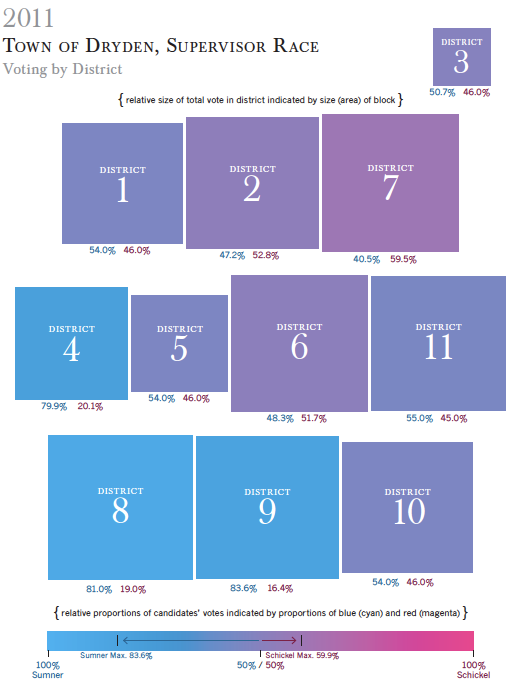
Dryden Supervisor's race, results.
If you click the picture, you'll get a PDF that's clearer and has an additional set of bar graphs on page 2.
I especially like this because the sizes of the boxes are determined by the number of voters, not by land area. It's a very quick way to assess the election, and note how blue the bluest boxes are while how purple the reddest boxes are.
November 13, 2011
Compulsory integration discussion Monday night
What does compulsory integration mean for you?
GAS DRILLING & COMPULSORY INTEGRATION: WHAT ARE YOUR RIGHTS?
Energy companies may be able to remove natural gas from your property even if you haven't signed a drilling lease due to the Compulsory Integration provisions of the New York Oil, Gas and Solution Mining Law. The public is invited to learn more about this topic and to ask questions at a free, educational forum on Monday, November 14 at the Dryden Fire Hall, 26 North Street in Dryden. Doors will open at 6:30 and presentations begin at 7:00 p.m. Presentations will be followed by question-and-answer period.
Topics to be covered include: an explanation of Compulsory Integration (CI) and its legislative history; an overview of compulsory integration hearings and your rights; impacts of CI on your land rights and how CI could affect your ability to obtain mortgages and loans.
Presenters include: NY State Assemblywoman Barbara Lifton (125th District); Kenneth Holden, Esq. of Hancock Estabrook in Syracuse, an attorney with extensive experience in natural gas leasing who has represented clients at compulsory integration hearings; Greg May, vice-president for Residential Mortgage Lending at Tompkins Trust Company; Carol Chock, TC Legislator and member of the TC Council of Governments Gas Drilling Taskforces Committee on Land Values/Assessment; and Nancy Larraine Hoffmann, farmer, spokesperson for Land Stewards of NY and former NY State Senator.
This forum is sponsored by the Cornell Cooperative Extension of Tompkins County and Fleased. For more information contact Sharon Anderson, Cooperative Extension of Tompkins County at 607-272-2292 or Ellen Harrison at 607-539-7133.
Here, it meant we were careful to make sure that the "no drilling" clause on the property we bought last year was a "no voluntary drilling", because it would have been terrible to have to return all of that property if we found ourselves caught in this bizarre web of sort of kind of mostly eminent domain for private purposes.
November 14, 2011
Former Dryden resident analyzing ancient Roman bones
Dryden residents past and present are doing all kinds of amazing things, but it's not every day that I click on a link at the CNN site and find a familiar-looking picture and name:
The remaining [Romans] - commoners, slaves and others - are largely silent. They could not afford tombstones to record their names, and they were buried with little in the way of fancy pottery or jewellery. Their lives were documented by the elites, but they left few documents of their own.
Now, Kristina Killgrove, an archaeologist from Vanderbilt University, wants to tell their story by sequencing their DNA, and she is raising donations to do it. "Their DNA will tell me where these people, who aren't in histories, were coming from," she says. "They were quite literally the 99% of Rome."
...Since 2007, Killgrove has been studying 200 skeletons recovered from lower-class graves excavated outside Rome's city walls. As they went about their lives, these Romans incorporated chemical isotopes from their water, food and environment into their bones and teeth. By measuring the levels of these isotopes, Killgrove could reconstruct the lives of her subjects.
Amazing stuff, all worth reading. I took Latin in high school and always found the Romans amazing - but figured that even though it was one of the calmer times in human history, there were only a few people really enjoying it.
(Killgrove taught archeology at SUNY Cortland while she was here, and is apparently at Vanderbilt now.)
Economic development done wrong
Tracy Marisa of the Dryden Safe Energy Coalition (and of the One of Nine blog) has a Guest Viewpoint on how New York's Regional Economic Councils are heading the wrong way. Most of it strikes me as the usual Republican "businesses are always smarter than governments and we should sell ourselves to businesses". I don't think that's worked out well lately, to put it mildly.
However, I agree with the piece that the Regional Council idea is not likely to make a big difference. Setting up a competitive battle between state regions in an age of declining funding seems like a giant PR stunt without much hope of creating results. New York has a long and painful history of offering tax breaks to beg companies to come here (or pretend to come here), with mixed results at best.
I'd much rather see us drop that kind of economic development dance, praying that we can lure someone in, and refocus what economic development we can do on making it easier for people already here to start businesses. Shareable facilities like commercial kitchens and workshops, training for adults, and finding ways to connect the strengths we already have make a lot more sense to me.
Marisa is also right that New York State's regulations could use drastic simplification, though I suspect that we'd completely disagree on what that "simple" should be. It's not an unusual problem.
(The comments are also interesting, as it looks like the right wing is slowly losing its iron grip on the Ithaca Journal's comment section. Also, you may want to visit our Regional Economic Development Council for more.)
In other news, the Tompkins County Council of Governments will host a hearing on the DEC's environmental impact statement on gas drilling December 1st, I guess because the DEC can't stand to have hearing in places where they might not have a majority in support. The DEC is holding a hearing in Danville, which isn't even close to the fairways, but much more supportive of drilling? What are they thinking?
The state thinks lots of Tompkins County schools need improvement. I have my doubts about the value of such assessments, but I'm sure we'll see lots more of them.
I noticed a quiet day on 366 last Thursday - I guess TCAT buses weren't running on this route because too many drivers called in sick. Union action?
In not-Dryden news, the rape arrest I'd mentioned earlier was actually in the Town of Ithaca, though the initial proceedings were in Dryden Town Court.
Dryden likely has several faults
The last time I wrote about, this, I was pointing to what looked like a single small faulted area in Dryden along the Caroline town line.
That came from Figure 4.13 in the Geology section of the hydrofracking SGEIS (4.2 MB PDF). It, in turn, is based on a 1977 New York State Museum publication, which I guess I'll have to order.
However, Dryden Daily KAZ sent me a link to this article about many more probable faults:
Robert D. Jacobi, professor of geology and chair of the Northeastern section, contends that he and colleagues have uncovered increasingly convincing evidence that upstate New York is severely chopped by hundreds of faults of a kind characterized by very sporadic seismic activity...
But using a variety of field and satellite methods, Jacobi's group has found that there are hundreds of faults throughout the Appalachian Plateau, some of which may have been seismically active-albeit sporadically-since Precambrian times, about 1 billion years ago....
The researchers identified potential fault lines using remote sensing by satellite and low-flying planes. They then employed field methods, as well as magnetic fields and gravity measurements, to determine if those potential fault lines are indeed faults and if the faults extend down into Precambrian "basement," an indication that they could be seismically active.
We only have about 200 years of data, and there is little sign that these faults are active, so I'm not entirely surprised that the DEC didn't consider this more recent information critical to the seismic section of their report. Unfortunately, though, faults are also a key pathway for gases and sometimes liquids to move up through rock formations we normally think of as solid.
I tracked down Professor Jacobi's 2002 paper, Basement faults and seismicity in the Appalachian Basin of New York State and paid Elsevier $31.50 for it. It was worth that, and I'd encourage you to do the same (or track it down at Cornell) though it's pretty dense reading. You'll want to know what lineaments are in particular.
How did they figure out where faults were without digging through the entire area?
Evidence utilized for recognition of faults in NYS included the integration of FIDs [fracture intensification domains], E97 [EARTHSAT 1997 satellite] lineaments (Fig. 2), topographic lineaments, gradients in gravity and magnetic data (Figs. 3 and 4, respectively), seismic reflection profiles, and well logs. Integration of these data sets promoted the identification of numerous faults in the study area (Fig. 5). This paper illustrates the evidence for the confirmed faults, and demonstrates the characteristics and ubiquity of the faults for western, central, and eastern NYS (Sections 2, 3, and 4, respectively). Suspected faults, those that are not confirmed by outcrop structures, well logs or seismic reflection profiles, are discussed in Appendix A. (79)
The faults running through Dryden are "suspected" - the researchers did not confirm their existence here through surface features or seismic testing. However, the paper strongly suggests that this approach to finding faults works, with tests in other locations.
The maps created by their work yield a suspected fault map of Tompkins County and its surroundings like:
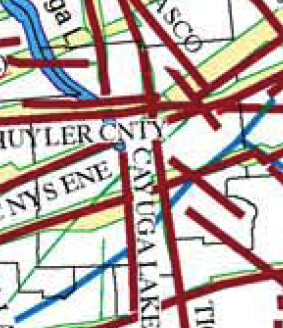
A more detailed look at suspected faults in Tompkins County. (fragment of Figure 5, page 86.)
That map shows two "X marks the spot" points of intersecting faults in Dryden. The smaller, more southern, one is along the Dryden-Caroline town line as before. The more northern one includes several different suspected faults - four or five, depending on how I count. The Tioga County fault runs north-south along what looks like Dryden's western edge, while the Schuyler County and Central New York State faults run east-northeast. The Owasco fault comes down from Auburn to about the Dryden-Groton line, where it intersects the Utica East fault (which is labeled near Utica on the map.)
Appendix A talks about those suspected faults, many of which are suspected because of both the 'lineaments' from satellite imagery and geological, mostly gravitational, anomalies. Some also run parallel to previously mapped faults. I'd encourage you to read pages 109 and 110 of the paper to find out more.
Don't run out and buy earthquake insurance. There's not much if any history of these faults being active, though (if they're really there) they've been around for millions of years and we only have around two centuries of records.
However, they make me think there's a lot more research worth doing before accepting the DEC's conclusions that we needn't worry about these issues with regard to gas drilling. More on that in my next piece about the SGEIS.
November 15, 2011
Zoning public hearing opens tomorrow night
The Town Board will open the public hearing for the proposed zoning law Wednesday night at 7:00pm, at Dryden Town Hall, 93 East Main Street.
I won't be able to be there, so I'll be sending written comments. Most of the stuff I think is badly broken moved into the subdivision law (now missing from that moved page!), but the mixed-use zone is still a terrible enough idea badly executed that it deserves protest now and correction later. (The law has been introduced, so changes would require a new round of public hearings.)
November 16, 2011
The gas industry and quakes in New York State
I wrote about faults the other day, and it already looks like I may have underestimated their impact in an age where we like to inject things deep underground.
There's also a piece on potential legal earthquakes from all of this. Remember, leases are a speculative investment at the best of times.
Comments on zoning for tonight's public hearing
I can't be at tonight's public hearing on the zoning, as I'll be at Village Hall helping out at the Dryden Town Historical Society's talk on the Southworth House.
As regular readers here will know, I'm not entirely sold on the new zoning. As much as I would like to go through the whole (finally released) draft and nitpick it, I decided to focus on the component I see as most likely to create major problems. Those problems will affect not just neighbors but anyone using our state highway, and change the tone of conversations about extending water and sewer in the future.
To the Dryden Town Board:
I recognize that you have put substantial work into the proposed zoning law, and I am glad that what you are considering passing right now does not include the badly broken subdivision law. There is, unfortunately, still one extremely ugly component in the zoning law that I would ask you to remove - or at least to amend out quickly.
Earlier drafts of the zoning law had a "commercial" zone which, like other non-residential districts, allowed four units per acre of housing in addition to the retail typically expected of a commercial zone.
There were complaints that the commercial zone was drawn to too small an area, so the Town appears to have added every parcel that ever was commercial to the map. This created a very strangely spotted map.
At the same time, the Town shifted from "commercial" to "mixed use commercial", a very different thing. Mixed use commercial allows, per §606, up to ten units per acre in areas where there is public water and sewer available. It is called "mixed use", but there is nothing in the zoning that requires these uses actually be mixed.
No other zone in the Town in the current zoning permits more than four units per acre. Even allowing for the addition of the Varna Master Plan's probable likely higher density for that hamlet, many of these formerly commercial zones are much more likely to sprout apartment complexes than retail establishments.
The combination of the Town's scattering commercial zones across the map and redefining commercial to mean "highest density housing allowed in the town by right" will lead to many unpleasant surprises for neighbors as well as housing in locations that were better suited for commercial use - and chosen expressly because they were good places for commercial use.
This approach is also in direct contradiction to the 2005 Comprehensive Plan's discussion of lessons learned from the problematic Route 13 corridor area, where much of the commercial zone has been placed:
The Rte. 13 corridor between Irish Settlement Road and Etna Lane poses a particular planning challenge. High traffic volumes adversely impact the utility of land adjacent to the highway for residential development. Also as the corridor experiences further development in the future, there is the potential for substantial increases in the level of congestion on Rte. 13 unless steps are taken now to control that potential.
The conflicts that have occurred where commercial and industrial development has occurred in close proximity to residences are an ongoing land use issue within the corridor. In several instances long-time residents of the area have been adversely impacted by new non-residential development adjacent to their properties. These newer industrial or commercial enterprises are seen as exacerbating the impact of the heavy traffic on the road. (61)
The Design Guidelines, now appendices to the main document, address some details of this, but the problems begin here, in the main body of the zoning.
I urge you to correct this major flaw in the zoning - by removing Section 606 - before it creates genuine controversy, about either either the placement of housing or the value of extending infrastructure.
I've objected to this for over a year, with little result, and it would be difficult at this point for the Town Board to strike Section 606 and references to it without holding a new public hearing, so I don't expect action on this. However, I also don't plan to let it go quietly.
If you can make it to the hearing, it's at 7:00pm at the Dryden Town Hall, 93 East Main Street (Route 392), Dryden. You can find the introduced law here.
November 17, 2011
Lots of Dryden happenings
I should probably script something on this site that grabs Cathy Wakeman's latest Dryden Town Talk and posts a link here saying go read it!
This week, of course, there's Dryden-related (Finger Lakes Fresh expanding to Groton with a state investment) and Freeville news in Groton Town Talk too.
When Africa bumped North America: cracks underground
I thought about calling this piece "Impacts of the Alleghanian Orogeny", but that just sounded too strange, even for an article based on writings of the patron geologist of the Marcellus Shale pointing out structures that help make drilling here dangerous.
Geology of New York: A Simplified Account is an extremely dense textbook, potent bedtime reading almost guaranteed to cure insomnia. It also, though, tells some critical stories explaining what lies beneath our surface. (It also comes with a great big map, which would look great on my wall except that I need both sides of it!)
So what happened?
the Alleghanian Orogeny lasted from about 330 to 250 million years ago.... proto-Africa was attached to eastern proto-North America. The orogeny produced the Applachian Mountains...
we now think that proto-Africa probably slid southward past proto-North America along a transform margin... As proto-Africa slid southward, it rotated clockwise, pushing westward into the southern part of proto-North America. This westward push produced large faults.... Only portions of New York State were deformed. (19)
Later, Africa moves away, the Atlantic Ocean opens, and this area becomes much quieter as far as earthquakes. However, even though we didn't end up with the Great Smoky Mountains here, that impact had major, if often invisible, effects.
Most of the chapter on the Erie Lowlands and Alleghany Plateau is pretty quiet, focusing on the formation of the rock below us and the waterflows that brought the material. However, at the end, as a supplement, is a section called 'Deformation of "Undeformed" Rocks: Structures in the Allegheny Plateau', which is "Adapted from text furnished by Dr. Terry Engelder, Pennsylvania State University".
If that name sounds familiar, it should. Engelder was one of the first geologists to promote the Marcellus Shale as a source of natural gas, earning himself a profile on This American Life that Penn State apparently didn't like very much. If you want an authoritative geologist who's a fan of the Marcellus Shale drilling, he's the one.
His stories challenge the stable-sounding deposition stories of the previous chapter:
The structure of rocks in the Alleghany Plateau looks deceptively simple — nothing but nearly horizontal sedimentary rock layers: "layer-cake geology". Folds like those commonly seen in the convoluted rocks of the Adirondacks, the Taconic Mountains, and southeastern New York are absent, and faults are rarely seen. However, despite this simple layer-cake appearance of the rocks of the region, subtle effects of the Alleghanian Orogeny are present in most of the rock exposures in central and western New York south of a line between Syracuse and Buffalo. (132)
How much compression was there? "Field Studies show that the Alleghanian Orogeny shortened the crust in the Alleghany Plateau by 10 percent (133)." Even over millions of years, shrinking a rock formation by 10% is pretty impressive. Even more impressive, that shrinking happened in place, without major breaks and folds.
Engelder presents evidence for such compression. That evidence is a set of deformations and breaks that are certainly useful for geological history, but also a warning that the bedrock beneath us is not as solid as we'd like to think:
What evidence for layer-parallel shortening can we see in individual rock exposures? We find the evidence in several types of structures, to be explained below: deformed fossils, pencil cleavage, spaced cleavage, blind thrusting, and drape folds. The first three are associated with flowing in the weak rock layers; the other two are connected with brittle breaks in the strong rock layers. (133)
All of these except the first, deformed fossils, create breaks in the rocks. Here are some of his explanations of cleavage in softer sedimentary rocks:
Rock cleavage refers to very closely-space parallel fractures. Cleavage develops in rocks that are being compressed. Sedimentary rock contains water in the microscopic openings (pore spaces) between its grains. When the rock is compressed, the water pressure is raised, and the water is forced upwards along microscopic passageways. As the water rises it dissolves silica... in the rock. This process is called pressure solution. It results in leaving behind parallel seams of insoluble clay minerals. The removal of rock material by solution along the cleavage planes causes the rock to shorten at right angles to the cleavage... If the rock has thin bedding planes as well as cleavage, the rock breaks along both, to form long narrow pieces called pencil. This kind of cleavage is called pencil cleavage...
Another kind of rock cleavage, called spaced cleavage, is a structure found in the Tully and Onondaga Limestones of western New York. [The Onondaga is below the Marcellus, the Tully above.] Like pencil cleavage, it forms in rocks under pressure, when pore water dissolves part of the rock and leaves and insoluble residue of clay. (134)
There are larger breaks, too:
The thin but strong layers (Tully and Onondaga Limestones and Oriskany Sandstone)... deformed not only by solution along cleavage seams, but also by faulting. Faulted segments were stacked up like roofing shingles... Because the thrust faulting is below the surface and is only rarely seen, it is called blind thrusting...
The faulting and stacking of the thin, strong limestone and sandstone layers created very low mounds beneath the surface. This arrangement caused the overlying shales to drape over these mounds in long, low, wave-like folds, called drape folds... We find such subtle folds scatted throughout the Allegheny Plateau.
Another kind of fracture is often visible on the surface in the Ithaca area, "characteristic of many of the outcrops in the Finger Lakes District of New York." (137)
The most common structures in rocks of the Allegheny Plateau are planar cracks, called joints.... The high water pressure that developed in the rocks during the Alleghanian Orogeny became great enough to drive vertical cracks through the rock. The rock literally split when the internal water pressure exceeded the strength of the rock.
Outcrops in the Finger Lakes district all show abundant vertical joints that were formed in this way. They may exceed 300m in length in cliff-faces. (135)
Those joints run roughly north-south, but there are also east-west release joints formed later, when higher rock was eroded:
rock that was once deeply buried and therefore under great pressure was unloaded and brought closer to the surface. With a lessening of pressure, the rock expanded. This expansion stretched the crust and led to the formation of joints. (137)
There's even one more round of joints, formed later, "as the rock cooled... roughly east-northeast... parallel to stresses found in the crust today." (137)
We have complicated terrain and soil maps here thanks to the glaciers and other erosion patterns. That's just the surface, though. Many more complications, largely unseen and unknown, lurk in the seemingly solid rock below us.
November 18, 2011
Diamond mines of Ithaca?
Geology of New York: A Simplified Account startled me with mention that there was kimberlite in the Ithaca area.
Kimberlite? In Ithaca? The stuff named after Kimberley, South Africa, and its 1870s diamond rush? An igneous rock coming through our sedimentary rocks?
But there it is, in the words of Terry Engelder:
During the Mesozoic Era [65-250 million years ago], some north-south joints in central and western New York became the passageways for magma that moved upward from the earth's mantle. The magma solidified to form kimberlite dikes, which are most concentrated in the vicinity of Ithaca. (Kimberlite is a dark-colored igneous rock.) Most of the dikes are a few centimeters thick, but some reach several tens of centimeters in thickness. (137)
It turns out that there are no diamonds in Ithaca's kimberlite:
However, one mineral that is found in the South African kimberlites but has never been found in those from New York is diamond. Furthermore, the mineral assemblage in our "kimberlites" indicates that they formed in the uppermost portion of the mantle, and were too cool for diamonds to be stable. Therefore, diamonds are not expected to be present in any of the currently known New York dikes.
Their description suggests bigger dikes:
These unusual rocks occur as narrow dikes that formed as molten rock from the upper portion of the earth's mantle pushed upwards into joints (vertical cracks) in the surrounding rock, then cooled, and solidified. The dikes range in size from an inch (2.5 cm.) or less, to 195 feet (60 m.) in width.
That site has great pictures if you scroll down, and more information. It's not just Ithaca. Visible kimberlite goes up to Syracuse, and:
There are undoubtedly many more dikes buried below glacial cover, under water, or that just haven't been recognized yet.
I'm not sure whether to think that kimberlite filled many of the gaps underneath us, or to worry that there were many gaps, and large ones, and that the kimberlite probably didn't find all of them outside of a very narrow belt. From what I've seen on the surface, I'm guessing most joints remain open.
But no diamonds, sorry!
Congressman Hanna coming to Varna Monday
Congressman Richard Hanna will be coming to the Varna Community Center, 943 Dryden Road, next Monday, November 21st, from noon to 1:30pm. This was canceled at one point, but a wave of robocalls suggests it's on again.
From what I can gather he seems to plan to talk to constituents in five minute sessions rather than have a broad town hall.
Not a surprising location for an accident
I try to arrange my drives to avoid left turns onto Route 13 almost anywhere except in the Village of Dryden. I'm not sure that was the problem in this three-car crash last night at Route 13 and Yellow Barn, but it's really not much fun there.
Makes me wonder about traffic lights again.
November 19, 2011
Video, audio of compulsory integration, fracking meetings
I didn't get to Monday's "Gas Drilling and Compulsory Integration: What Are Your Rights?" event, but there's full video available from Shaleshock.
The DEC hearings on the fracking SGEIS in Dansville (11/16) and Binghamton (11/17) are also available from WSKG, audio-only, at:
It's a lot to absorb.
November 20, 2011
Goodbye, Godric
We buried Godric, a sweet little tiger cat, yesterday after Angelika found him dead by the side of Route 366 near Saunders Greenhouse. It looked like he'd been hit hard and thrown into the ditch.
Keeping cats here is difficult. We think we've lost two to coyotes, and now Godric to the road. Invisible Fence collars sort of theoretically work on cats, except that we've found that cats are much better at removing them than dogs, and there's no good way to train a cat about how the fence works. We could close the dog door, but our dog would not be very happy with us either.
Godric was a fantastic hunter (mostly of rodents, fortunately), a bold explorer of our woods who liked to follow us around out there, an excellent climber, great with the kids, the cleanup crew for any spilled or leftover milk, and a wonderful friend to our older fluffball cat Puschelwuschel.
He was also our ambassador to the raccoons, apparently.

Godric the cat talks with raccoon
We'll miss you, Godric.
November 21, 2011
"Fingers were wiggled"
The Ithaca Journal headline promised "high drama" in their story about the Binghamton DEC hearing, but somehow we get a "boisterous" crowd that wiggles their fingers.
I guess I won't see that in the audio from WSKG.
November 22, 2011
Finger Lakes Land Trust receives Fall Creek parcel
12 acres with 2000 feet of frontage on Fall Creek just took a step toward remaining natural this week, as the Finger Lakes Land Trust reports:
The Land Trust announced today that it has accepted the donation of a 12-acre parcel that features more than 2,000 feet of frontage on Fall Creek. The property is located in the Town of Dryden on State Route 366, just upstream of the hamlet of Etna and is the ninth conservation project completed by the Land Trust along Fall Creek....
"We're grateful to Elizabeth and Roger for this thoughtful memorial to James Henderson," says Land Trust Executive Director Andrew Zepp. "The property provides excellent habitat for fish and wildlife and will help ensure water quality within Fall Creek and Cayuga Lake. It is also part of a growing network of protected lands along the creek."
The Henderson property features hardwood forests on both sides of a shallow stretch of the creek that is populated by countless crayfish. It also encompasses several grassy islands within Fall Creek. Abundant birdlife found in the area includes regular use by Great Blue Herons, ducks, and geese. Access to the site is provided by a gravel pull-off located on the west side of Route 366, just south of its intersection with Kirk Road.
In addition to this latest acquisition, the Land Trust also owns and manages conservation areas along the creek just downstream of Etna, near the hamlet of McLean, and adjacent to Lake Como near Fall Creek's headwaters. The organization has also partnered with the Town of Dryden and the Village of Freeville to secure additional lands in this area.
(Thanks to Hilary Lambert for the tip!)
Update: And here it is in the Ithaca Journal.
November 23, 2011
What the DEC doesn't want you to know about injection and earthquakes
I'm not especially impressed with the Marcellus Shale SGEIS, but the DEC seems to go out of its way to fuel my suspicions that the document is pretty much a sham:
That passage [of the SGEIS] cites as a reference a consultant's report prepared for the state by Alpha Environmental Services in 2009. Page 141 (or page 153 in the Acrobat numbering system) of that Alpha document contains nearly identical language about the Avoca incident, and cites as its reference a document it calls "Pratt, Dave, April 19, 2001. 'Deep Well Injection and Triggered Earthquakes.' Internal DECDMR working document."
So I asked DEC for a copy of this document, hoping it would shed light on what happened in Avoca 10 years ago, and what that company might have done - or been allowed to do - that triggered the earthquakes. I was told to file a Freedom of Information request. I did. The response was promised for Monday, and that's when it arrived.
The result was a bit of a letdown. About two-thirds of the two-page memo was blacked out. I don't think the portions you can read shed much light at all, but you can judge for yourself.
That's from Steve Orr's blog at the Rochester Democrat and Chronicle. He was the author of the recent article asking questions about hydrofracking and earthquakes in the Ithaca Journal.
Thankful for Dryden, and a few things left to work on
Successful Dryden Town Board candidate Linda Lavine wrote a thank-you letter in today's Ithaca Journal:
Every workday, as I drive 12 miles through the back roads of Dryden, I give thanks for the beauty of this land. I pass homes, villages, Fall Creek, lovely old barns, fields of horses, cows and corn. I have driven this path for 40 years now, and never tire of it.
As Thanksgiving approaches, I wish to publicly express my gratitude to the people of Dryden, for caring enough to preserve the integrity and natural beauty of this land by their vote.
Kathy Zahler of Freeville points out a few things Dryden (schools) still need to work out with the state:
The property tax cap is working. It is working to maintain the divide between rich and poor and to ensure that children in poor upstate districts have no chance at all to improve their lot in life....
Dryden educates 12 times as many students as Bridgehampton with just three times the money. But Dryden has had budgets fail with a 50-50 vote. Do you really think that Dryden will dare to ask voters to override the tax cap? Remember, rollover budgets put everyone over the cap. To stay within the cap means to lose services, not just to maintain what we have.
Murray Cohen of Dryden asks hard questions about Christianity and politics:
We are probably not as familiar with this remark by Jesus: "But woe to you that are rich, for you have received your consolation" (Luke 6:24). And then there is this poetically powerful admonition: "Do not lay up for yourselves treasures on earth, where moth and rust consume and where thieves break in and steal, but lay up for yourselves treasures in heaven ... for where your treasure is, there will your heart be also" (Matthew 6:19).
Am I missing something, or is there an inherent contradiction between Jesus as the embodiment of God and the Republican vision of wealth and the worldly life of acquisition as the optimum good?
Beyond the Viewpoints page, which feels all Dryden all the time today, there's also mention of Freeville resident Joy Hines participating in Occupy Ithaca's camp.
November 24, 2011
Helping after the flood
Dryden only had minor flooding, but those to our south and east were less lucky. The Ithaca Journal looks at help coming to Tioga County, with a photo of Greg Kimbell of Dryden.
November 28, 2011
Ludgate Farms closing; sale starts Tuesday
It had been up for sale since June, but I'd hoped for a happier ending:
We are writing to let you know that we closed Ludgate's Farm & Market at the end of business today (Sunday, Nov 27). We will reopen our doors this Tuesday to conduct a final inventory liquidation. The liquidation sale will run from Nov 29th through Dec 15th. All sales will be final; no further discounts will be applied or coupons or gift certificates accepted. Store hours during this period will be: Noon - 7pm.
A large part of me would really like to jump in and run this business, but between no capital and no experience, I pretty clearly can't.
Update: Here's the Ithaca Journal on the story.
Asking the wrong questions about groundwater and gas
Unlike other more plausible sections of the geology chapter of the draft SGEIS on shale gas drilling (4.2MB PDF), I knew that the last section - 4.7, Naturally-Occurring Methane in NYS - was broken from the first time I read it.
What made that so clear, when I'm not a geologist?
They go way, way, way out of their way to avoid asking the basic question this section of the SGEIS needs to answer:
Does gas drilling increase the risk of contaminating groundwater supplies with methane?
The draft SGEIS refuses to go anywhere near that question. The one time it gets kind of sort of close, it cherrypicks data to paint a bright smiley face on a study that concludes the opposite of what the SGEIS claims.
What we do get is four pages of excuses for other possible reasons methane might appear in groundwater. "Methane in groundwater? Quick, look over there!"
The presence of naturally-occurring methane in ground seeps and water wells is well documented throughout New York State. Naturally-occurring methane can be attributed to swampy areas or where bedrock and unconsolidated aquifers overlie Devonian-age shales or other gas-bearing formations....
Often landowners are not aware of the presence of methane in their well. Methane is a colorless, odorless gas, and is generally considered non-toxic but there could be an explosive hazard if gas is present in significant volumes and the water well is not properly vented....
[Examples of non-drilling-related methane...] (4-37)
My favorite section is what I call the "Excuses" paragraph:
Methane contamination of groundwater is often mistakenly attributed to or blamed on natural gas well drilling and hydraulic fracturing. There are a number of other, more common, reasons that well water can display sudden changes in quality and quantity. Seasonal variations in recharge, stress on the aquifer from usage demand, and mechanical failures are some factors that could lead to degradation of well water. (4-37)
Yes, all of those things can happen. There was a fire during well-drilling in Freeville last year, and I knew people in Lansing who were frustrated by several methane strikes - not enough to heat the house - while trying to put in a new water well. It doesn't seem like anyone figured out what happened to wells near the intersection of Ellis Hollow, Turkey Hill, and Quarry roads, a few years ago, either.
The hard question, though, isn't whether there's gas in the ground. We know that there is. The question is whether that gas can move because of drilling, and not just when the drillers can't be bothered to cement their well casings properly.
There's one sentence that gave me a brief moment of hope:
Drilling and construction activities may have an adverse impact on groundwater resources. (4-38)
The rest of that paragraph, though, wanders away into things the DEC might be able to control, avoiding questions about what they might not be able to control.
The migration of methane can contaminate well water supplies if well construction practices designed to prevent gas migration are not adhered to. (4-38)
Chapter 6 talks about the importance of well casing construction - which is important but only part of the story. It concludes with language ("perceived to be related") that dismisses other kinds of concerns:
Section 4.7 of this document explains how the natural occurrence of shallow methane in New York can affect water wells, which needs to be considered when evaluating complaints of methane migration that are perceived to be related to natural gas development. (6-42)
Chapter 7 at least requires "Baseline water quality testing of private wells within a specified distance of the proposed well" (7-42), and the distance turns out to 1,000 feet, or 2,000 feet if there are no wells closer. That's a small start, though given that the SGEIS has put so much effort into claiming methane contamination is natural and unrelated, I can't help wondering how much data it would take for the state to consider taking a second look.
Returning to section 4.7, the SGEIS notes that:
In April 2011 researchers from Duke University (Duke) released a report on the occurrence of methane contamination of drinking water associated with Marcellus and Utica Shale gas development. (4-38)
Rather than discuss the actual conclusions of that study of wells in New York and Pennsylvania, the DEC homes in on one tiny piece of potential good news in the study. If you look at only the nine wells they tested in Otsego County, there were minimal amounts of methane. Of course, only one of those wells was within a kilometer of a gas well, and that one well had less methane than the rest of the wells. Never mind that the main criticism of the Duke study seems to be its limited sample size, and that a sample size of one doesn't offer anything statistically.
So what did that study really find? The headline Methane Levels 17 Times Higher in Water Wells Near Hydrofracking Sites gives the story away, but the paper itself makes clear that this isn't just pockets of methane near the surface. Some of it clearly comes from deep down, and bad well casings alone aren't enough of an explanation:
Methane concentrations were detected generally in 51 of 60 drinking-water wells (85%) across the region, regardless of gas industry operations, but concentrations were substantially higher closer to natural-gas wells (Fig. 3). Methane concentrations were 17-times higher on average (19.2 mg CH4 L−1) in shallow wells from active drilling and extraction areas than in wells from nonactive areas... The average methane concentration in shallow groundwater in active drilling areas fell within the defined action level ... for hazard mitigation recommended by the US Office of the Interior (13), and our maximum observed value of 64 mg L−1 is well above this hazard level (Fig. 3). Understanding the origin of this methane, whether it is shallower biogenic or deeper thermogenic gas, is therefore important for identifying the source of contamination in shallow groundwater systems.
The average δ13C-CH4 value in shallow groundwater in active drilling areas was −37 ± 7‰, consistent with a deeper thermogenic methane source. In contrast, groundwater from nonactive areas in the same aquifers had much lower methane concentrations and significantly lower δ13C-CH4 values (average of −54± 11‰; P < 0.0001; Fig. 4 and Table 1). Both our δ13C-CH4 data and δ2H-CH4 data (see Fig. S2) are consistent with a deeper thermogenic methane source at the active sites and a more biogenic or mixed methane source for the lower-concentration samples from nonactive sites).
Because ethane and propane are generally not coproduced during microbial methanogenesis, the presence of higher-chain hydrocarbons at relatively low methane-to-ethane ratios (less than approximately 100) is often used as another indicator of deeper thermogenic gas (14, 15). Ethane and other higher-chain hydrocarbons were detected in only 3 of 34 drinking-water wells from nonactive drilling sites. In contrast, ethane was detected in 21 of 26 drinking-water wells in active drilling sites. Additionally, propane and butane were detected (>0.001 mol %) in eight and two well samples, respectively, from active drilling areas but in no wells from nonactive areas. (page 2)
So how does that deeper gas climb through the formations?
There are at least three possible mechanisms for fluid migration into the shallow drinking-water aquifers that could help explain the increased methane concentrations we observed near gas wells (Fig. 3). The first is physical displacement of gas-rich deep solutions from the target formation. Given the lithostatic and hydrostatic pressures for 1-2 km of overlying geological strata, and our results that appear to rule out the rapid movement of deep brines to near the surface, we believe that this mechanism is unlikely.
A second mechanism is leaky gas-well casings (e.g., refs. 27 and 28). Such leaks could occur at hundreds of meters underground, with methane passing laterally and vertically through fracture systems.
The third mechanism is that the process of hydraulic fracturing generates new fractures or enlarges existing ones above the target shale formation, increasing the connectivity of the fracture system. The reduced pressure following the fracturing activities could release methane in solution, leading to methane exsolving rapidly from solution (29), allowing methane gas to potentially migrate upward through the fracture system.
Methane migration through the 1- to 2-km-thick geological formations that overlie the Marcellus and Utica shales is less likely as a mechanism for methane contamination than leaky well casings, but might be possible due to both the extensive fracture systems reported for these formations and the many older, uncased wells drilled and abandoned over the last century and a half in Pennsylvania and New York....
Several models have been developed to explain the relatively common phenomenon of rapid vertical transport of gases (Rn, CH4, and CO2) from depth to the surface (e.g., ref. 31), including pressure-driven continuous gas-phase flow through dry or water-saturated fractures and density-driven buoyancy of gas microbubbles in aquifers and water-filled fractures (31). More research is needed across this and other regions to determine the mechanism(s) controlling the higher methane concentrations we observed. (page 4, paragraph breaks added)
The good news in the study is that fracking fluids, brine, or other liquids are unlikely to climb up from the Marcellus depths. The bad news is that gases, once freed, may be able to find their way up through a series of fractures I described here earlier.
The Duke researchers seem to recognize that this isn't the end of the story - the article concludes, even beyond the quote above, with a call for more study. Unlike the DEC's draft SGEIS, though they've found something that looks painfully significant, they don't argue that the science here is settled. Their final call to arms is a political one - a call for open data:
We believe that systematic and independent data on groundwater quality, including dissolved-gas concentrations and isotopic compositions, should be collected before drilling operations begin in a region, as is already done in some states. Ideally, these data should be made available for public analysis, recognizing the privacy concerns that accompany this issue. Such baseline data would improve environmental safety, scientific knowledge, and public confidence. Similarly, long-term monitoring of groundwater and surface methane emissions during and after extraction would clarify the extent of problems and help identify the mechanisms behind them. (page 5)
Right now, it looks to me like the DEC's main purpose in this section of the report is to protect drillers. At least in theory, that doesn't resemble the DEC's mission. Whoever wrote this section misread the DEC's assignment, or worse.
Update: This discussion of back and forth between industry supporters and the Duke researchers is interesting, but has no effect on the DEC's grotesque misuse of the data.
"Super Lawyer" flies again
Apparently Super Lawyer Thomas West cannot rest in his work for the gas industry and its friends. He's now representing the landowner plaintiffs as a co-counsel in the Middlefield lawsuit as well as leading the attack on Dryden.
November 29, 2011
Dryden schools to vote on capital improvements
Next Monday, December 12th, voters in the Dryden Central School District will get to vote on proposals for improving school buildings, repaving the parking lot, and establishing a new capital fund:
Every five years, New York state requires all school districts to conduct a facilities condition survey, Superintendent Sandy Sherwood said. After all district buildings were inspected last year, the facilities advisory committee recommended the proposed projects to the school board, she said...
This proposition includes: sanitation upgrades, roof repairs, foundation masonry repairs, chimney and brick repointing, intrusion-detection systems, window replacements and exterior stair repairs.
All of the proposals are designed to have no effect or minimal effect on the immediate tax levy, relying on state funds and funds already saved for the purpose - except the third, which establishes a new fund for future projects five years out.
Fleased meeting Sunday
Fleased - "providing a voice for fellow landholders who leased mineral rights before we knew that shale gas exploitation threatened our land, air, water, and communities" - will be meeting this Sunday at the Dryden Fire Hall:
SIGNED A GAS LEASE?
Concerned about risks to your property, your neighbors, and the environment? Want to know about lease termination?
Please join us!
Fleased General Meeting
December 4th, 2-4 PM
Dryden Fire Hall
26 North St
Dryden, NY 13053Bring your lease and get your questions answered!
Presenters:
Ellen Harrison, Fleased Director
Joe Heath, General Counsel for the Onondaga Nation and environmental attorneyWe will also be joined by:
Michael Danaher and Dennis McCabe from the Office of the Attorney General
November 30, 2011
Holidays coming to Dryden; economic development proposals
Cathy Wakeman reports on a variety of holiday happenings and more in her Dryden Town Talk column, starting with the Christmas tree lighting this Saturday, December 5th, on the Village Green in the Village of Dryden.
There's also a piece on the economic development proposals from the Southern Tier Regional Council.
